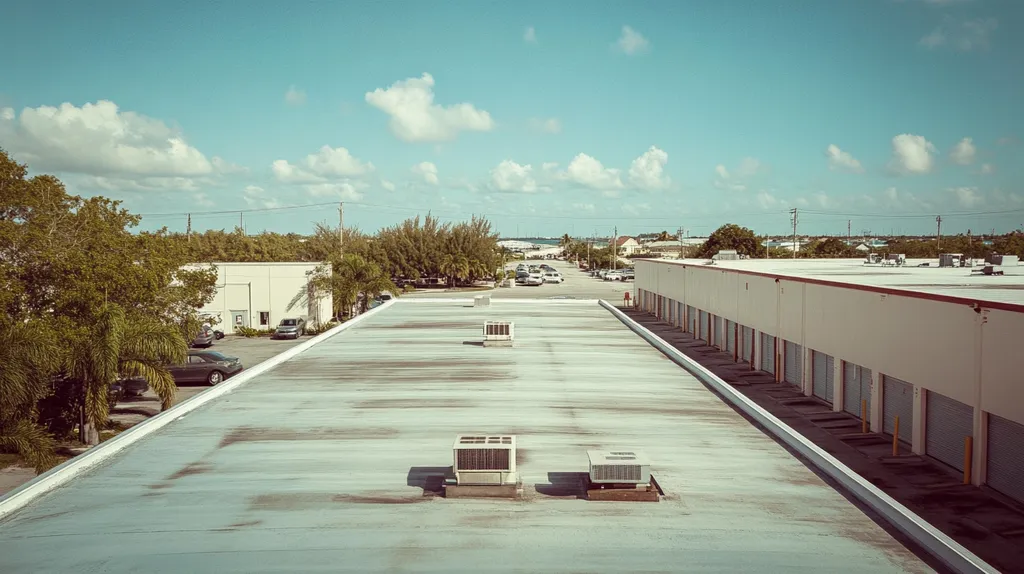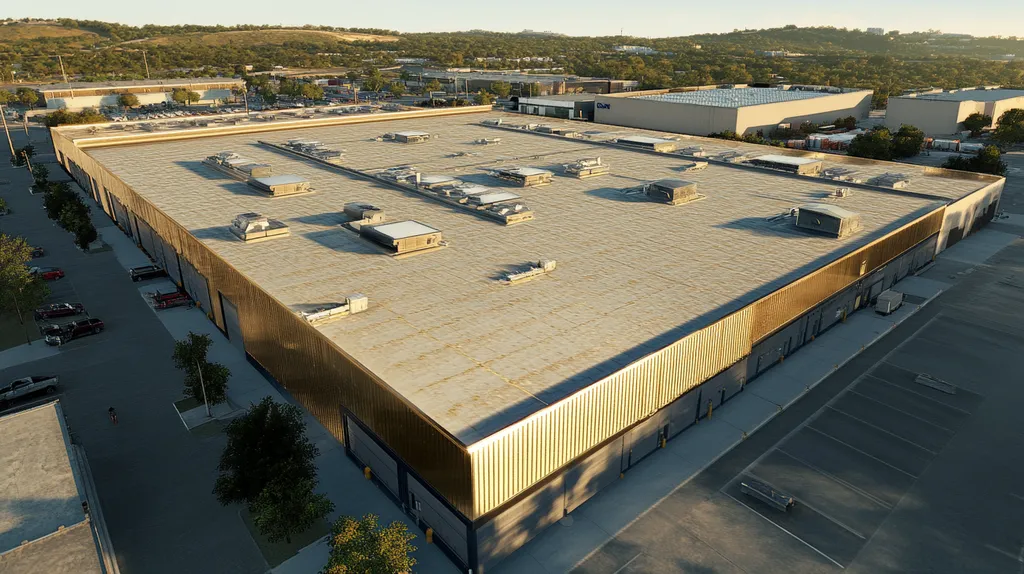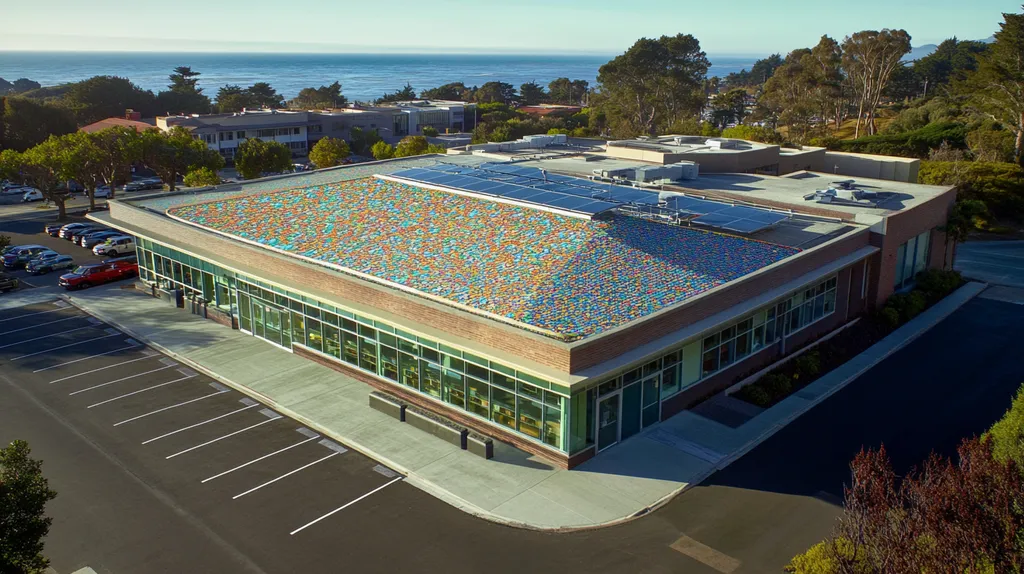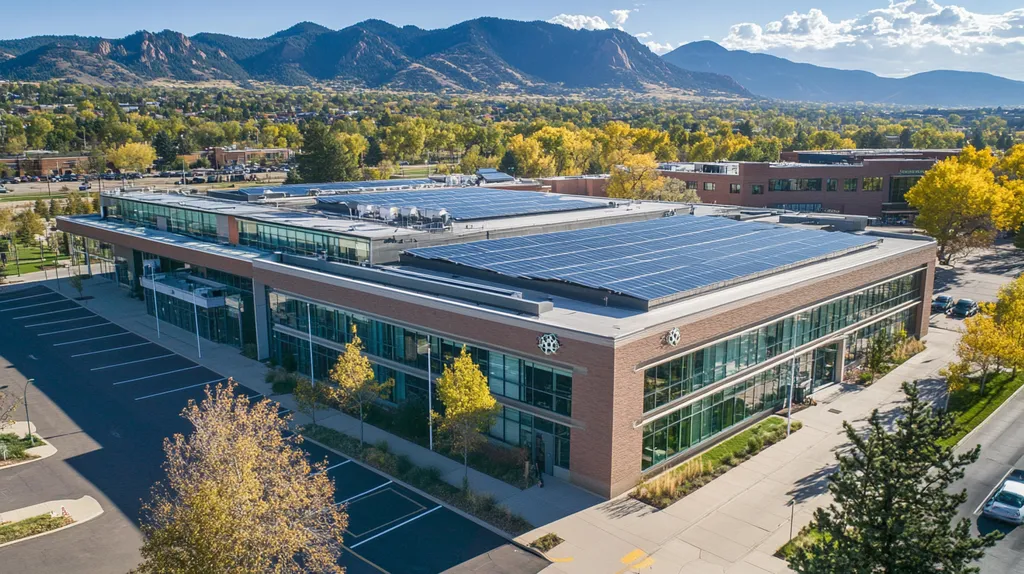In an era where commercial roofing failures cost businesses over $2.5 billion annually, staying ahead of technology trends isn’t just smart—it’s essential for survival. Today’s roofing innovations are revolutionizing how facilities protect their assets and manage energy costs.
From AI-powered leak detection to sustainable materials that slash cooling expenses by 30%, the latest advances offer unprecedented control over building performance and maintenance costs.
This comprehensive guide examines six critical areas facility managers must master: performance metrics, financial planning, compliance requirements, risk management, operational procedures, and long-term sustainability strategies.
SECTION 1: PERFORMANCE FACTORS
The stakes have never been higher in the world of commercial roofing! Did you know that nearly 30% of a facility’s energy costs can be traced back to poor roofing systems? With energy prices soaring and extreme weather becoming the new normal, it’s crucial for facility managers to focus on roofing performance. This section will dive into three essential factors that can dramatically impact your bottom line: energy efficiency and cooling costs, durability and weather resistance, and smart monitoring technologies. Addressing these issues isn’t just smart—it’s key to maximizing the value of your roof investment.
Energy Efficiency and Cooling Costs
Energy-efficient roofing solutions are a game changer when it comes to saving costs. Many facilities are now using reflective roofing materials that significantly reduce heat absorption, leading to lower cooling bills. For example, installing white or light-colored membranes can drop rooftop temperatures by up to 30°F, resulting in energy savings of 20% or more.
Furthermore, adopting cool roofing technologies is becoming increasingly popular. These innovative products not only save money on energy but can also enhance the longevity of the roofing materials themselves, creating a winning scenario for cost-effectiveness and durability.
Facility managers should prioritize energy-efficient designs for both new installations and retrofits. Combining insulation and ventilation with reflective materials will maximize energy performance, addressing both soaring energy costs and overall building comfort.
Key Action Items
Durability and Weather Resistance
With weather patterns growing more unpredictable, durability has become a critical aspect of roofing. Extreme storms, hail, and temperature fluctuations demand materials that can endure these elements. Newer, stronger roofing membranes are rising to the challenge, featuring enhanced flexibility and resistance.
For instance, thermoplastic polyolefin (TPO) and ethylene propylene diene monomer (EPDM) membranes stand out for their excellent weather resistance and longevity. Designed for high performance, they often last more than 30 years with minimal upkeep. This level of durability not only reduces interruptions but also cuts lifecycle costs.
It’s essential for facility managers to prioritize quality installation, as even the best materials can fail if improperly installed. Investing in experienced roofing professionals ensures that durability claims are realized, keeping roofs intact and efficient long-term.
Key Action Items
Smart Monitoring and Leak Detection
The integration of technology into facility management is revolutionizing how roof performance is monitored. Smart monitoring systems provide real-time data about roofing conditions, helping identify potential problems before they become significant. These technologies can track changes in temperature, moisture levels, and overall structural health.
For example, advanced sensors send alerts for leaks or signs of deterioration, enabling proactive maintenance rather than reactive repairs. This approach not only saves money but also reduces downtime, leading to smoother facility operations.
Incorporating smart technologies into the roofing maintenance strategy is vital for sustaining optimal performance. While the initial investment may seem steep, the long-term savings from preventing water damage and roof failures can be substantial.
Key Action Items
SECTION 2: FINANCIAL CONSIDERATIONS
The financial implications of adopting new roofing technologies can feel overwhelming for facility managers and property owners. With roofing systems taking a sizable chunk out of building maintenance budgets, it’s vital to grasp the cost versus benefit. Research shows that switching to advanced roofing materials can lead to significant long-term savings. This section dives into the economic landscape of the latest roofing technologies, their associated maintenance costs, and the returns on investment tied to energy-efficient roofs.
Cost-Benefit Analysis of New Materials
A thorough cost analysis is vital when evaluating new roofing materials. While the initial investment might raise eyebrows, advanced systems often boast superior durability and longer lifespans. For instance, thermoplastic polyolefin (TPO) roofs, known for their high reflectivity, not only boost energy efficiency but also call for fewer repairs.
In contrast, traditional asphalt roofs typically need replacing every 15-20 years, accumulating significant expenses over time. Facility managers must consider the total cost of ownership and not just the initial price tag.
Additionally, opting for durable materials can positively influence insurance premiums. Longer-lasting roofing systems reduce the likelihood of damage claims, adding financial advantages. This holistic view of costs should inform decisions about upgrading roofing technology.
Key Action Items
Long-Term Maintenance and Repair Costs
Long-term maintenance plays a crucial role in roofing expenses. New roofing technologies often require less upkeep, translating into lower costs over time. For example, cool roofing systems reflect sunlight, helping manage lower temperatures and minimizing deterioration from extreme heat.
Installing advanced materials like single-ply membranes or modified bitumen can significantly cut down on repair needs, an advantage facility managers can leverage to control budgets effectively.
Establishing a maintenance plan that acknowledges the expected lifespan of these new materials is crucial. Regular inspections can catch potential issues early, preventing costly repairs down the line. By investing in higher-quality roofing materials, facility managers can enjoy substantial savings by avoiding frequent replacements.
Key Action Items
ROI on Energy-Efficient Roofing Solutions
The return on investment (ROI) generated by energy-efficient roofing solutions is worth serious consideration. Studies indicate that energy-efficient roofs can deliver an impressive ROI of 20-30% within just a few years. By embracing sustainable roofing technologies, facility managers can slash energy bills while supporting environmental initiatives.
Energy-efficient roofs, including green roofs or those with reflective surfaces, substantially lower heating and cooling demands. This reduction in energy consumption translates into significant savings, further underscoring the financial benefits of these systems.
Furthermore, many states offer enticing tax credits or rebates for energy-efficient upgrades, boosting financial returns even more. These incentives can substantially lessen overall costs and enhance ROI for facility managers.
Key Action Items
SECTION 3: COMPLIANCE REQUIREMENTS
In a rapidly changing commercial roofing landscape, compliance isn’t just a box to check; it’s a lifeline for effective facility management. Falling short on regulations can lead to significant penalties, safety risks, and unexpected delays in projects. Alarmingly, outdated roofing systems leave properties facing a 30% higher chance of facing regulatory penalties. This section highlights the key compliance challenges facility managers must tackle, including evolving building codes, environmental standards, and fire safety regulations.
Stricter Building Codes and Regulations
Building codes are tougher than ever, reflecting the need for enhanced safety and durability in roofing materials and designs. Many municipalities are adopting these stricter standards to keep pace with technological advancements and the necessity for climate-ready structures. For instance, roofs in areas susceptible to severe weather are now required to withstand intense wind forces and heavy rain.
Non-compliance is not an option for facility managers. Failing to adhere to these codes can result in forced closures until necessary upgrades are made, disrupting business operations, and impacting tenant safety.
Conducting regular audits of roofing systems to ensure they meet local and national codes is a proactive step in preventing violations. Partnering with a knowledgeable roofing contractor familiar with these regulations also guarantees compliance from the get-go.
Key Action Items
Environmental and Sustainability Standards
With environmental awareness on the rise, many regions have adopted standards aimed at improving sustainability in roofing materials. These standards focus on reducing ecological footprints, promoting energy efficiency, and encouraging the use of recyclable materials. For instance, cool roofing technologies can significantly cut energy consumption by reflecting sunlight and minimizing heat absorption.
Awareness of LEED (Leadership in Energy and Environmental Design) certification is essential for facility managers, as sustainable building certifications can enhance property appeal and value. Meeting these sustainability standards can also lead to financial incentives, making your roofing upgrades even more beneficial.
Understanding local zoning laws and how they relate to eco-friendly materials is crucial for compliant installations. This insight is vital for making sound decisions that balance sustainability with regulatory requirements.
Key Action Items
Fire-Resistant and Safety Compliance
Prioritizing fire safety compliance is critical for facility managers. Certain roofing materials, especially in commercial spaces, must meet specific fire-resistant ratings to mitigate hazards. The National Fire Protection Association (NFPA) outlines these crucial guidelines, and failing to comply can have dire consequences, including financial liability and property loss.
Consultation with the current NFPA codes is necessary during project assessments to ensure compliance with fire safety standards. Neglecting these regulations could expose properties to unnecessary risks that can be avoided with proper adherence.
Regular training and updates on fire safety codes for facility managers and the maintenance team ensure everyone understands their role in maintaining compliance and protecting assets.
Key Action Items
SECTION 4: RISK MANAGEMENT
In the high-stakes world of commercial roofing, effective risk management is essential for ensuring building safety and uninterrupted operations. A staggering one-third of all commercial roofing failures are linked to leaks and extreme weather challenges. Facility managers must be proactive in spotting risks to minimize costly repairs and enhance long-term sustainability. This section focuses on strategies to prevent leaks, tackle extreme weather, and avert structural failures.
Identifying and Mitigating Potential Leaks
Leaks can spring from a variety of culprits, including improperly installed flashing, wear from aging, and damage inflicted by storms. Early detection of potential leak sources can lead to significant cost savings for property owners. Regular inspections should emphasize vulnerability points like seams, joints, and roof penetrations that are most at-risk.
Employing modern detection technologies—like infrared thermography and drone inspections—can dramatically improve leak identification. These innovative tools facilitate thorough evaluations of roof conditions that traditional methods may overlook. Catching hidden problems before they escalate is essential.
During routine maintenance, promptly addressing minor concerns can prevent them from leading to major leaks. Facility managers should also train staff to observe warning signs, such as water stains or mold growth, and report them without delay. Maintaining clear gutters and drains to ensure proper water flow minimizes the risk of leaks caused by pooling, enhancing operational resilience and prolonging roof lifespans.
Key Action Items
Managing Extreme Weather Conditions
As climate change escalates the frequency and intensity of extreme weather events, facility managers must adapt their roofing strategies accordingly. Winds exceeding 60 mph can rip off roof membranes, leading to disastrous failures. It’s vital to design and construct roofs with local weather patterns in mind to mitigate this risk.
Selecting high-quality materials that are durable under tough conditions significantly decreases the likelihood of damage. Thermoplastic polyolefin (TPO) and ethylene propylene diene monomer (EPDM) membranes stand out for their ability to endure severe temperature fluctuations and heavy downpours.
Moreover, establishing a robust drainage system is crucial to preventing water accumulation, which can cause leaks or even structural collapse. Installing well-designed rooftop features—like scuppers or drains—effectively combats heavy rainstorms. Updating emergency response plans for extreme weather, including staff training and inspections after severe events, is equally critical.
Key Action Items
Preventing Structural Damage and Collapse
Maintaining structural integrity is paramount in any commercial roofing system. Weaknesses due to excess water weight, corrosion, or inferior materials can pose serious safety risks, including potential collapse. Regular assessments focusing on roof loading capacities and compliance with local building codes are essential to preventing these issues.
Investing in high-performance roofing materials, such as reinforced membranes, can help solve structural concerns by accommodating greater loads without failure. A solid understanding of the facility’s unique design requirements aids in choosing effective materials.
Ongoing maintenance, including debris removal and structural assessments, is vital to catch minor issues before they escalate. Facility managers should make this a priority to uphold building safety standards and prolong roof lifespan. In emergencies, having quick access to preventative structural reinforcements, like temporary supports, can be crucial in averting disasters.
Key Action Items
SECTION 5: OPERATIONAL PROCEDURES
In the fast-paced world of commercial roofing, overlooking operational procedures can result in costly repairs and safety hazards. Alarmingly, a study indicates that 75% of roofing failures are linked to inadequate maintenance practices. Establishing routine inspections and effective training programs is crucial for maximizing the longevity and performance of roofing systems. This section highlights essential procedures for facility managers, showcasing the role of modern inspection technologies and the need for thorough staff training.
Routine Inspection and Maintenance Checklists
Routine inspections are indispensable for identifying roofing problems before they escalate into costly repairs. Facility managers should create a checklist emphasizing essential elements such as water pooling, seam integrity, and flashing evaluation. This proactive strategy can catch minor issues early, saving thousands in potential repairs.
Seasonal inspections should be implemented, paying special attention to critical areas like gutters and drainage systems. For instance, inspecting roofs post-heavy rain can prevent leaks caused by debris accumulation. A consistent maintenance approach not only enhances reliability but also extends the roof’s lifecycle.
Thorough documentation of inspections is vital. Keeping detailed records assists with warranty claims and provides insights into the roof’s condition over time. This historical data helps in making informed choices regarding future repairs or replacements.
Finally, engaging roofing professionals for semi-annual comprehensive assessments can reveal problems that untrained eyes might miss, offering an additional layer of protection for facility assets.
Key Action Items
Drone and AI-Driven Inspection Techniques
The use of drones and AI technology for roof inspections is revolutionizing the way facilities monitor roof conditions. Drones can swiftly capture high-resolution images, enabling detailed visual assessments of roofs that are hard to access safely, thus minimizing safety risks during inspections.
AI software analyzes footage from drones to identify issues like cracks and wear. This approach accelerates the inspection process while enhancing accuracy, as algorithms can detect patterns that may go unnoticed by human inspectors. For instance, an AI system can highlight areas requiring immediate attention, streamlining targeted maintenance efforts.
Furthermore, drones provide a holistic view of the roofing system without the need for physical contact, which is ideal for extensive or layered roofs. Enhanced data collection allows for better forecasting regarding maintenance needs and helps with budget planning.
By integrating these advanced techniques into routine operational procedures, facility managers can proactively address potential problems, ensuring safety and operational efficiency.
Key Action Items
Training for Facility Maintenance Personnel
Investing in training for facility maintenance staff is imperative for effective operational procedures. Well-informed personnel are better equipped to undertake routine inspections and maintenance tasks, ensuring roofing systems receive necessary attention. Training programs should encompass topics like material properties, common failure modes, and safety protocols.
Fostering a culture of continuous learning keeps staff informed about the latest roofing technologies and methodologies. Offering workshops or webinars on advancements like cool roofing or green roofs can enhance their skills and awareness. Additionally, hands-on training fosters practical competence in maintenance tasks.
Encouraging a collaborative atmosphere where staff share knowledge and experiences can strengthen team cohesion. Regular meetings to discuss roofing issues allow for shared best practices, boosting overall efficiency.
Facility managers should prioritize ongoing education as part of annual initiatives. Investing in staff training not only improves day-to-day operations but also builds long-term resilience for the roofing system.
Key Action Items
SECTION 5: OPERATIONAL PROCEDURES
In the dynamic world of commercial roofing, neglecting operational procedures can lead to significant long-term costs, safety hazards, and structural failures. A startling 75% of roofing failures are attributed to inadequate maintenance practices. Establishing regular inspections and effective training is essential for optimizing the longevity and performance of roofing systems. This section details key procedures that facility managers should adopt, highlighting the use of modern inspection technologies and the importance of comprehensive staff training.
Routine Inspection and Maintenance Checklists
Regular inspections are critical for spotting potential roofing problems before they turn into costly repairs. Facility managers should create a checklist that focuses on essential elements like checking for water pooling, inspecting seams, and evaluating the integrity of flashing. This proactive approach helps catch minor issues early, potentially saving thousands in repairs.
Implementing seasonal inspections is also beneficial, with a focus on critical areas such as gutters and drainage systems. Inspecting roofs after heavy rains can prevent leaks caused by debris buildup, enhancing reliability and extending the roof’s lifespan.
Moreover, proper documentation of these inspections is vital. Keeping detailed records aids in warranty claims and provides insights into the roof’s condition over time. This history is invaluable when making informed decisions about repairs and replacements.
Lastly, engaging roofing professionals for comprehensive assessments every six months can unveil issues that untrained eyes might overlook, further safeguarding the facility’s assets.
Key Action Items
Drone and AI-Driven Inspection Techniques
Utilizing drones and AI technology for roof inspections is transforming facility management practices. Drones can rapidly capture high-resolution images, providing thorough visual assessments of roofs that might be challenging to access safely. This innovation minimizes the need for ladders or scaffolding, significantly reducing safety risks during inspections.
AI software enhances this process by analyzing drone footage to detect issues such as cracks or wear. This speeds up inspections and improves accuracy, allowing algorithms to identify potential problems that human inspectors might miss. For instance, AI can pinpoint areas needing immediate attention, streamlining maintenance efforts.
Moreover, drones offer a holistic view of the roofing system without physical contact, which is particularly useful for complex or multi-layered roofs where traditional inspection methods may not suffice. Enhanced data collection through these techniques aids in better forecasting maintenance needs, aligning with budget planning and resource allocation.
Integrating drones and AI into routine operational procedures ensures facility managers remain ahead of potential roofing issues, fostering safety and operational efficiency.
Key Action Items
Training for Facility Maintenance Personnel
Investing in training for facility maintenance staff is essential for establishing effective operational procedures. Knowledgeable personnel are equipped to conduct routine inspections and handle maintenance tasks, ensuring roofing systems receive the attention they need. Training programs should cover crucial topics such as material properties, common failure modes, and safety protocols.
Fostering a culture of continuous learning keeps team members informed about the latest roofing technologies and practices. Hosting workshops or webinars on advancements like cool roofing or green roofing can deepen their knowledge and skills. Additionally, providing hands-on training enhances practical competencies for maintenance tasks.
Furthermore, creating a collaborative environment where staff can share experiences improves team morale and effectiveness. Regular meetings to discuss roofing challenges can lead to best practice sharing and increased overall operational efficiency.
Facility managers should emphasize ongoing training as part of annual initiatives. Investing in staff development not only enhances day-to-day operations but also fortifies the long-term resilience of the roofing system.
Key Action Items
Looking Ahead
With commercial roofing failures costing businesses over $2.5 billion annually, staying current with technological advances isn’t optional—it’s imperative for survival.
The integration of AI-driven monitoring, sustainable materials, and drone inspections is revolutionizing how facilities protect their assets and manage costs.
Smart monitoring systems can now detect potential failures weeks before they occur, while advanced materials can slash energy costs by up to 30%.
As building codes become stricter and weather patterns more extreme, facility managers must embrace these innovations to ensure their properties remain compliant, efficient, and protected.
The future of commercial roofing lies in the strategic adoption of these technologies, supported by comprehensive training programs and data-driven maintenance protocols.
FREQUENTLY ASKED QUESTIONS
Q. How does roofing performance affect commercial roof energy costs?
A. Roofing performance significantly influences energy expenses. Poor insulation and high heat absorption can lead to astronomical cooling costs. By upgrading to reflective materials or cool roofing systems, facility managers can cut cooling bills and enhance energy efficiency, creating a smarter and more sustainable environment.
Q. What are the financial benefits of choosing energy-efficient industrial roofs?
A. Energy-efficient industrial roofs provide long-term financial benefits through substantial energy savings and lower maintenance costs. While the initial investment may be higher, the reduction in energy consumption and fewer repairs can lead to significant savings over time, increasing the overall return on investment.
Q. How can compliance risks affect commercial roofing projects?
A. Non-compliance with regulations can lead to legal penalties, project delays, and safety risks. Facility managers must stay updated on building codes, environmental regulations, and safety standards to ensure their roofing projects comply, avoiding potential liabilities and maintaining operational efficiency.
Q. What strategies minimize risks associated with leaks in commercial roofs?
A. Regular inspections, modern leak detection technologies, and prompt repairs are crucial. Employing preventive measures like sealing vulnerable points and maintaining drainage systems can significantly reduce the risk of leaks, thereby minimizing costly repairs and operational disruptions.
Q. Why are operational procedures vital in managing a commercial roof?
A. Effective operational procedures ensure timely inspections and maintenance, drastically reducing failures caused by neglect. With proper frameworks in place, facility managers can extend the lifespan of roofs, minimize safety hazards, and safeguard assets, leading to long-term cost savings.
Q. How can training enhance maintenance for commercial roofing systems?
A. Training equips maintenance personnel with the knowledge to spot issues early, apply best practices, and handle modern technologies. By fostering a culture of continuous learning, staff can enhance overall efficiency and address maintenance challenges proactively, extending the life of commercial roofs.
Q. What innovations are shaping the future of industrial roofing?
A. Innovations like smart roofing technologies, green materials, and improved insulation methods are reshaping industrial roofing. These advancements promote energy efficiency, environmental sustainability, and enhanced durability, allowing facility managers to invest in roofing solutions that save money and protect resources long-term.











